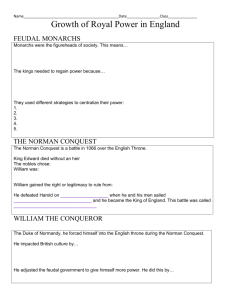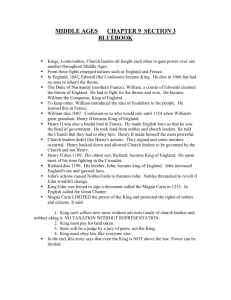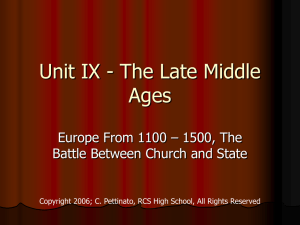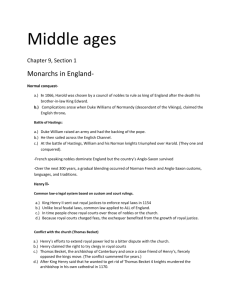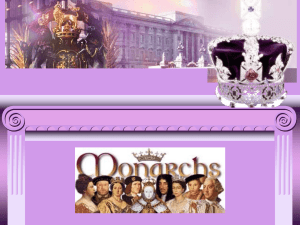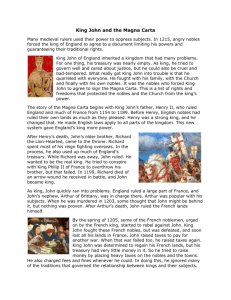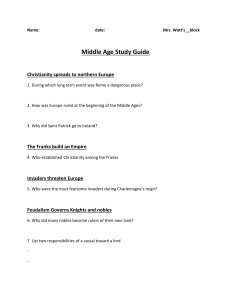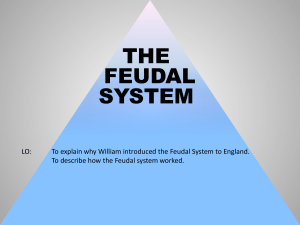Lecture 9: Medieval Period
advertisement
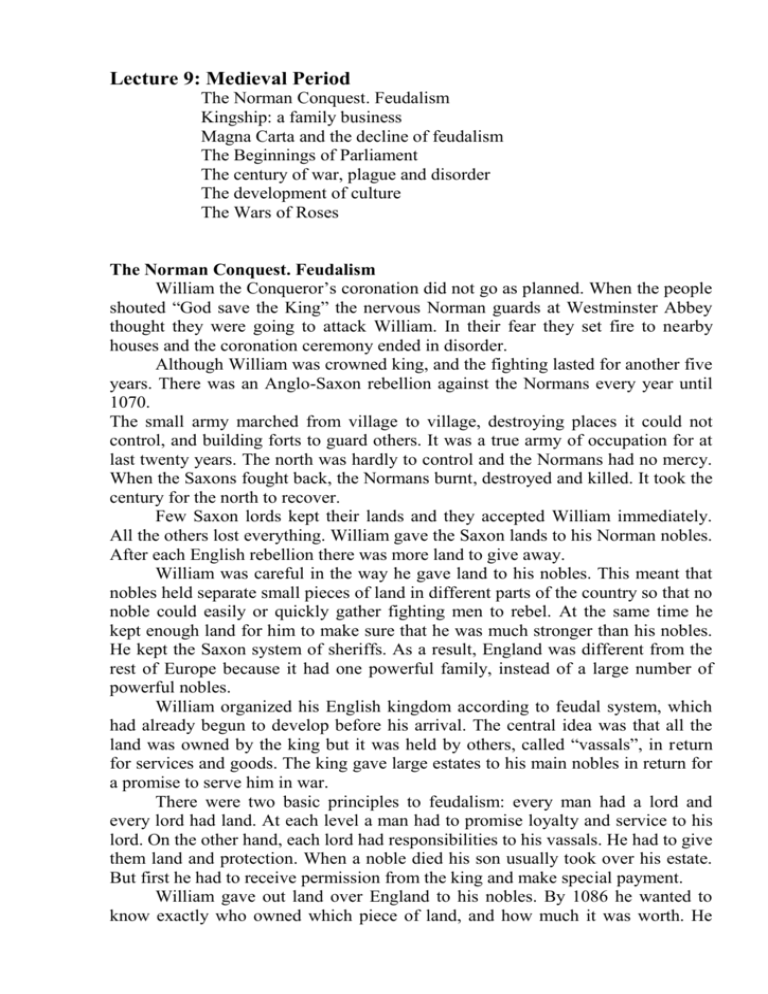
Lecture 9: Medieval Period The Norman Conquest. Feudalism Kingship: a family business Magna Carta and the decline of feudalism The Beginnings of Parliament The century of war, plague and disorder The development of culture The Wars of Roses The Norman Conquest. Feudalism William the Conqueror’s coronation did not go as planned. When the people shouted “God save the King” the nervous Norman guards at Westminster Abbey thought they were going to attack William. In their fear they set fire to nearby houses and the coronation ceremony ended in disorder. Although William was crowned king, and the fighting lasted for another five years. There was an Anglo-Saxon rebellion against the Normans every year until 1070. The small army marched from village to village, destroying places it could not control, and building forts to guard others. It was a true army of occupation for at last twenty years. The north was hardly to control and the Normans had no mercy. When the Saxons fought back, the Normans burnt, destroyed and killed. It took the century for the north to recover. Few Saxon lords kept their lands and they accepted William immediately. All the others lost everything. William gave the Saxon lands to his Norman nobles. After each English rebellion there was more land to give away. William was careful in the way he gave land to his nobles. This meant that nobles held separate small pieces of land in different parts of the country so that no noble could easily or quickly gather fighting men to rebel. At the same time he kept enough land for him to make sure that he was much stronger than his nobles. He kept the Saxon system of sheriffs. As a result, England was different from the rest of Europe because it had one powerful family, instead of a large number of powerful nobles. William organized his English kingdom according to feudal system, which had already begun to develop before his arrival. The central idea was that all the land was owned by the king but it was held by others, called “vassals”, in return for services and goods. The king gave large estates to his main nobles in return for a promise to serve him in war. There were two basic principles to feudalism: every man had a lord and every lord had land. At each level a man had to promise loyalty and service to his lord. On the other hand, each lord had responsibilities to his vassals. He had to give them land and protection. When a noble died his son usually took over his estate. But first he had to receive permission from the king and make special payment. William gave out land over England to his nobles. By 1086 he wanted to know exactly who owned which piece of land, and how much it was worth. He needed this information so that he could plan his economy; find out how much was produced and how much he could ask in tax. He sent a team of people through England to make a complete economic survey. Kingship: a family business To understand the idea of kingship and lordship in the early Middle Ages it is important to realize that at this time there was little or no idea of nationalism. William controlled two large territories: Normandy, which he had been given by his father, and England, which he had won in war. Both were personal possessions, and it did not matter to the rulers that the ordinary people of one place were English while those of another place were French. To William the important difference was that as duke of Normandy he had to recognize the king of France as his lord, whereas in England he was king with no lord above him. When William died in 1087, he left the Duchy of Normandy to his eldest son, Robert. He gave England to his second son, William, known as “Rufus” (Latin for red) because of his red hair and red face. When Robert went to fight the Muslims in the Holly Land, he left William II (Rufus) in charge of Normandy. William Rufus died in a hunting accident in 1100, shot dead by an arrow. He had not married and had no son to take the crown and Robert was on his way to Normandy from the Holly Land. Their younger brother, Henry, acted very quickly: he rode to Westminster, where he was crowned king three days later. Robert was very angry and prepared to invade. The Norman nobles in England had to choose between Henry and Robert. This was not an easy task because most of them held land in Normandy too. In the end they chose Henry because he was in London and with the crown on his head. Robert’s invasion was a failure. In 1106 Henry invaded Normandy and captured Robert. Normandy and England were reunited by one ruler. In the 12th century a new dynasty was established in England – the so-called Plantagenet dynasty. Henry II (1154-89) became King of England.(note: Henry I’s daughter Matilda was married to a great noble in France, Geoffrey Plantagenet, an heir to Anjou, Henry II was her son) He came from France. To his new English possessions he soon added some Scotch territory, established his lordship over Wales and made conquests in Ireland. Henry II was the first English king to attempt the conquest of Ireland. The country was seriously divided with little central government. Henry II himself crossed the Irish Channel and became recognized as Lord of Ireland. However, he succeeded in establishing his authority only in a small district around Dublin. To rule such a vast domain Henry had to have considerable money. So he introduced new taxes. Henry had four sons, two of which died in his lifetime. When Henry died he was succeeded by Richard (his son), best known as the Lionhearted, who loved adventure and conflict. Richard I has always been one of England’s most popular kings, although he spent hardly any time in England. He was brave and a good soldier, he fought with skill, courage and honor. On Richard’s death John, the fourth son of Henry, became king (1199-1216). John Lackland, as he was known in English history because he practically lost everything that he possessed, thought himself above the existing feudal laws and used the most evil means for forcing money out of his people. The towns were made to pay all kinds of taxes and fines. John was unwise to make an attack on the church over the filling of a vacant seat of Archbishop of Canterbury, when the Catholic Church was extremely powerful. Pope Innocent made use of the situation in England and persuaded the kings of France and Scotland to make war on him. John’s forces were crushed and the English barons refused to fight. Unwillingly he submitted and on June 15, 1215, at a field called Runnymede by the river Thames John signed the programme of demands expressed by the barons in a document known as Magna Charta or the Great Charter. Magna Carta and decline of feudalism This new agreement was known as “Magna Carta”, the Great Charter, and was an important symbol of political freedom. The king promised all “freemen” protection from his officers, and the right to a fair and legal trial. At the time most were not free, and were serfs or little better. Hundreds of years later, Magna Carta was used by Parliament to protect itself from a powerful king. In fact, Magna Carta gave no real freedom to the majority of people in England. Nobles who wrote it and forced King John to sign it had no such thing in mind. They had one main aim: to make sure John did not go beyond his rights as feudal lord. Magna Carta marks a clear stage in the collapse of English feudalism. Feudal society was based on links between lord and vassal. But the nobles were not acting as vassals but as a class. They established a committee of twenty-four lords to make sure John kept his promises. In addition, the nobles were acting in cooperation with the merchant class of towns. The nobles did not allow John’s successors to forget this charter and its promises. Every king recognized Magna Carta, until the Middle Ages ended in disorder. There were other signs that feudalism was changing. When the king went to war he had the right to 40 days’ fighting service from each of his lords. But forty days were not long enough for fighting a war in France. The nobles refused to fight for longer, so the king was forced to pay soldiers to fight for him. At the same time many lords preferred their vassals to pay them in money rather than in services. Vassals were gradually beginning to change into tenants. Feudalism, the use of land in return for service, was beginning to weaken. The Beginnings of Parliament King John signed Magna Carta unwillingly, and it quickly became clear that he was not going to keep to the agreement. The nobles rebelled and soon pushed John out of the southeast. But civil war was avoided because John died suddenly in 1216. John’s son, Henry III, was only nine years old. During the first sixteen years as king was under the control of powerful nobles, and tied by Magna Carta. Henry was finally able to rule for himself at the age of 25. It was understandable that he wanted to be completely independent of the people who had controlled his life for so long. He spent time with foreign friends and became involved in expensive wars. All this upset the nobles and once again they acted as a class, under the leadership of Simon de Montfort, the earl of Leicester. In 1258 they took over the government and elected a council of nobles. De Montfort called it a parliament (a French word meaning “a discussion meeting”). This parliament took control of the treasury and forced Henry to get rid of his foreign advisers. The nobles were supported by the towns, which wished to be free of Henry’s heavy taxes. But some of the nobles did not support the revolutionary new council and remained loyal to Henry. With their help Henry was able to defeat and kill Simon de Montfort in 1265. Once again he had full royal authority. When he died in 1272 his son Edward I took the throne without question. Edward I brought together the first real parliament. De Montfort’s council had been called a parliament, but it included only nobles. It had been able to make written laws and political decisions. However, the lords were less to provide the king with money. The king could raise the income by taxation. Several kings had made arrangements for taxation before, but Edward I was the first to create a representative institution, which could provide the money he needed. This institution became the House of Commons. Unlike the House of Lords it contained a mixture of “gentry” (knights and other wealthy freemen from shires) and merchants from the towns. These were the two broad classes of people who produced and controlled England’s wealth. In 1275 Edward I commanded each shire and each town to send two representatives to his parliament. England was special because the House of Commons contained a mixture of gentry belonging to the feudal ruling class and merchants and freemen who did not. The co-operation of these groups, through the House of Commons, became important to Britain’s later political and social development. The century of war, plague and disorder; the development of culture The 14th century is known in the English history as the century of war, plague and disorder. In the 1330s England began a long struggle against the French Crown. England had the additional burden of fighting the Scots, and maintaining control of Ireland and Wales, both of which were trying to throw off English rule. Edward III and his eldest son, the Black Prince, were greatly admired in England for their courage on the battlefield and for their courtly manners. They became symbols of the “code of chivalry”. According to this code, the perfect knight fought for his good name, served God and the king, and defended any lady in need. These ideas were expressed in the legend of the round Table around which King Arthur and his knights sat at equals in holy brotherhood. Chivalry was a useful way of persuading men to fight by creating the idea that the war was a noble and glorious thing. The year 1348 brought an event of far greater importance than the creation of a new order of chivalry. This was the terrible plague, known as the Black Death, which reached almost every part of Britain during 1348-9. Probably one-third of the entire population died, and fewer than one person in ten who caught the plague managed to survive it. Whole villages disappeared and some towns were most deserted until the plague itself died out. The rise in price and increased tax resulted in revolt in East Anglia and Kent, two of the richer parts of the country. During the 14th century discontent with the church also grew. The greed of the church was one obvious reason for its unpopularity. The church was a feudal power and often treated its peasants and townspeople with such a cruelty as the nobles did. The threat to the church was the spread of religious writings, which were popular with an increasingly literate population. These writings allowed people to pray and think independently of church control. The development of culture. Speaking about the development of culture in feudal England we must say that already in the early Middle Ages there developed an interest in learning. Schools were established with theology and philosophy added to the curricula. Classical literature declined in popularity, and a greater interest developed in medicine, astronomy, and other sciences. Laws and history also received some attention. In England two schools of higher learning were established, the first at Oxford and the second at Cambridge, at the end of the twelfth century. By the 1220s these two universities were the intellectual leaders of the country. The increase in the number of private and official documents also contributed to later historical knowledge of the period. Scholars began to use their own language instead of Latin for writing and thus tended to fix the form of a literary English. In 1440 Eton College was founded. The famous Inns of Court were beginning to train lawyers in London. Many other schools were opened at this time, because there was a growing need for educated people who could administer the government, the church, the law and trade. Clerks started grammar schools where students could learn the skills of reading and writing. These schools offered their students a future in the church, or in the civil service, or at the universities of Oxford and Cambridge. Grammar schools were accessible only to the rich. Of the works of literature of this period most outstanding was The Canterbury Tales by Geoffrey Chaucer (1342-1400). Besides, English literature has a great wealth of traditional folk poetry. This ranges from ballades, like the Robin Hood cycle, religious songs as well as love songs. From the 12th century to the 15th century is the great period of English Gothic architecture, the most striking instances of which are the many fine cathedrals throughout the country. Among them are Wells Cathedral, Salisbury Cathedral, the Chapel of King’s College, Cambridge and others. With the spread of literacy, cultural life in Britain naturally developed also. In the cities, plays were performed at important religious festivals. They were called “mystery plays” because of the mysterious nature of events in the Bible. After the Norman Conquest the English language (the old Anglo-Saxon language) continued to be spoken by ordinary people but was no longer written. By the end of the 14th century English was once again a written language, because it was used by the ruling, literate class. But the language of the 14 th and 15th centuries was very different from Anglo-Saxon. This was partly because it had not been written for three hundred years, and partly because it had borrowed so much from Norman French. The Middle Ages ended with a major technical development: William Caxton’s first English printing press, set up in 1476. Caxton had learnt the skill of printing in Germany. At first he printed popular books (Canterbury Tales). Books suddenly became cheaper and more plentiful, as the quicker printing process replaced slow and expensive copywriting by hand. Printing began to standardize spelling and grammar. The wars of the Roses. The 15th century was an age of violent contrasts. This age is marked with two parallel processes going in full swing. While feudal relations and the feudal mode of production were decaying, bourgeois relations and the bourgeois mode of production were developing rapidly. The decline of the feudal estate created favorable conditions and made it possible for internal wars to rage all over the country. The Wars of the Roses were the vivid expression of the anarchy of the period. The term “Hundred Years War” stands for a series of wars occurred, not just one war, and these wars lasted, counting intervals of peace, for more than a hundred years. In form it was a dynastic struggle between two most powerful feudal families – the House of Lancaster that had the emblem of the red rose and the House of York with the emblem of the white rose. Henry VI, who had become king as a baby, grew up to be simple-minded and book-loving. He hated warlike nobles and was unsuitable for such a violent society. England had lost a war and was ruled by a mentally ill king. The nobles were divided between those who remained loyal to Henry VI, the Lancastrians, and those who supported the duke of York, the Yorkists. The duke of York was the son of the earl of March, who had lost the competitions for the throne when Richard II was deposed in 1399. In 1460 the duke of York claimed the throne for himself. The various noble families related to these two Houses formed ranks behind them. Towns loyal to Yorkist families closed their gates to all Lancastrians. The court shut out all Yorkists. London was filled by armed followers of both parties. After terrible struggle and bloodshed the war ended in 1485. The battle of Bosworth, fought on August 22, 1485 ended the Wars of Roses and with them a whole epoch in England. Henry of Richmond or Henry Tudor won this battle against Richard III quickly as half of Richard’s army changed the sides. Henry Tudor was crowned king immediately, on the battlefield. (Richard III was killed in the battle). Henry was wise enough to marry the heiress of the House of York. Thus Henry formed a new monarchy, the Tudor monarchy, which was based upon a new relationship in society. It was under Henry VII, at the close of the 15th century that Britain was emerging as a centralized national state. Note: The crisis of kingship During the 14th century there was a continuous struggle between the king and his nobles. Edward II was deposed and killed. His son, Edward III – 11 years old, became king. Towards the end of the 14th century Richard II was king. He had no children. There were two possible successors. One was the earl of March, the seven-year-old grandson of Edward III’s second son. The other was Henry of Lancaster. Henry was stronger and he won the support of other powerful nobles and took the crown by force. Richard died mysteriously soon after.
